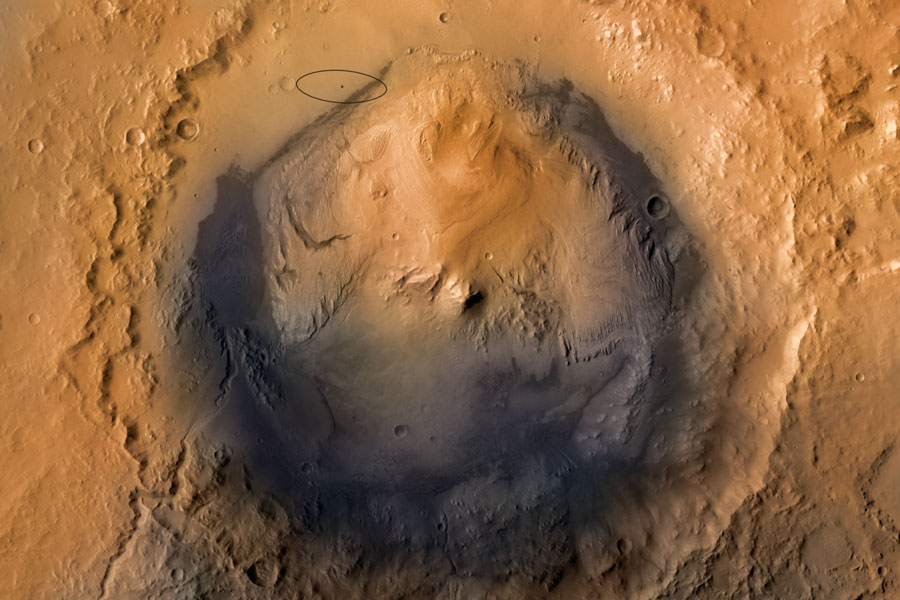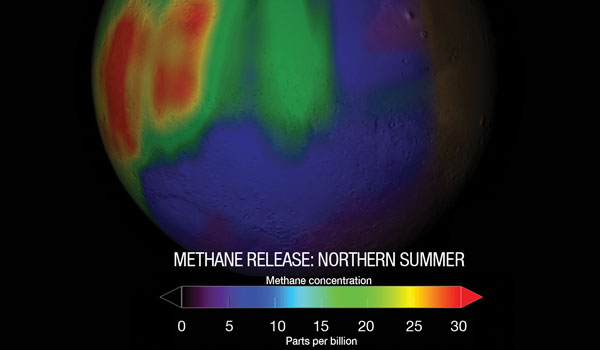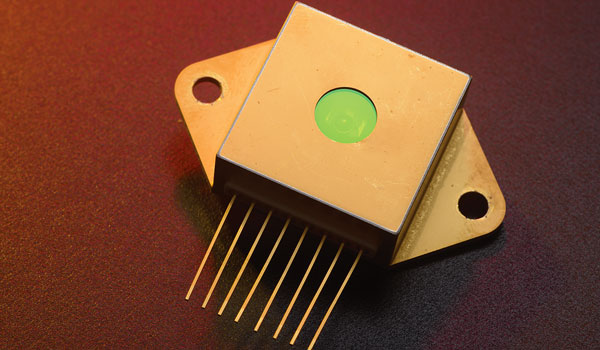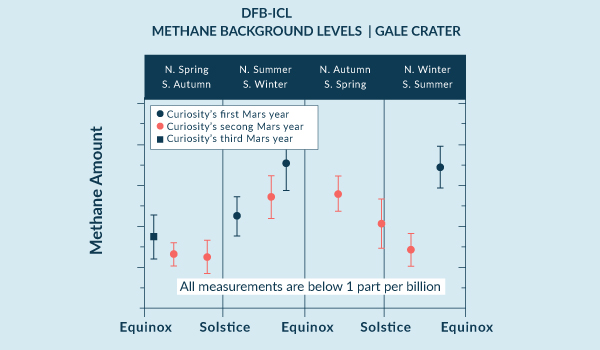Above:
Mars’ Gale Crater is a fascinating place to explore because of the mountain of layered materials in the middle. The layers tell a story about what Mars was like in the past, perhaps spanning some of the most geologically exciting parts of the history of the red planet.
TLS Mars
Lasers on Mars Keep Going
Siamak Forouhar - Chris Webster
The tunable laser spectrometer (TLS) aboard the Mars Science Laboratory Curiosity rover—using lasers developed and space-qualified at MDL— has paved the way for semiconductor lasers to play an important role in future planetary science missions with applications in spectroscopy, laser altimeters, and metrology. “TLS has been an incredible success for MDL, the Instrument Division, and JPL. “I am so very proud of the TLS team (design, fabrication, integration, and test) who have ensured that this instrument would continue working so well, for so long, and so far from home,” said Chris Webster, the TLS Principal Investigator in 2017. “After 5 years on Mars, TLS is alive and well, and continues to produce high-impact science on Curiosity. The instrument is performing exactly as it did some 6 years ago pre-ship, with no deterioration in performance or capability. As a result of its success, TLS is part of concept studies for New Frontiers Venus and Saturn Probe missions. We are currently building a mini-TLS for CubeSats and other small platforms under internal research and technology development funding, enabled by our successful mini-digital electronics efforts. As far as science, the TLS results have been the principal subject of six papers in the journal Science, and generated several hundred news stories across the world.”
The optimum absorption wavelength for methane and its isotopes is at 3.27 µm. Before the development of the interband cascade laser (ICL) invented by Rui Yang, there were no existing technologies that could allow emission near 3.27 µm with performances (output power and working temperature) that were suitable for space applications. MDL’s ICL was specifically designed by Yang and others to overcome those issues. The developed lasers went through extensive reliability and flight qualification testing. This has allowed the development of robust lasers that are working flawlessly without any degradation in the harsh environment of Mars since Curiosity’s landing in 2012.
TLS has achieved some noteworthy successes, that included detection of Mars methane. In addition to observing a pulse of high (7 ppbv—parts per billion by volume) methane on Mars in 2013, 2014, that has not recurred to date, TLS has been monitoring sub-ppbv background levels to reveal a seasonal dependence that may establish the connection between UV radiation and methane production from organic infall. Measurement of D/H in ancient Mars water: Measurements showed that D/H values in water evolved from rock pyrolysis that were only three times those on Earth (compared to six times those in the Martian atmosphere). This indicates that at an earlier time the Gale Crater region had significant liquid water, with a global equivalent layer of ~150 m depth. Measurements of atmospheric CO2 isotope ratios on Mars at unprecedented accuracy: Isotope ratios of C and O in CO2 show that the Mars atmosphere has changed little in 4 billion years. It is a key result for models of planetary evolution that the carbon-13 and carbon-12 results form a balance between atmospheric loss and carbonate formation. Measurements of 13C/12C isotopic ratios from methane evolved from Martian rock samples show clear differences between sample groups, and may reflect the presence of surface organics.
Detection of fine spectral line structures seen in Mars rock pyrolysis as “mystery lines” are identified with oxychlorines and represent production from degradation of surface perchlorates. As a bonus, TLS detected a strong HF line produced from Mars rock pyrolysis that is being used to identify fluorine-containing minerals. These results and others have validated the use of TLS on future missions to Mars and other worlds. JPL’s commitment to the development of TLS and related devices will continue to pay dividends as we expand our exploration of the solar system and beyond.
The NASA Exceptional Technology Achievement Medal is presented to Dr. Webster by Deputy Director Larry James and former Director Dr. Charles Elachi.
+ Larger image
Concentrations of methane discovered on Mars using ground-based telescopic measurements by Mumma et al. 2004.
+ Larger image
A low-power dissipation interband cascade (IC) laser fabricated at MDL inside a package designed specially for TLS. This device emits at 3.27 µm and is designed to target absorption lines of CH
4 for in situ measurements.
+ Larger image
NASA’s Curiosity Mars rover has detected fluctuations in the tiny background concentration of methane in the atmosphere, showing episodic high-level release and also a seasonal dependence to the background values, implying activity in the modern environment of Mars (Webster et al. Science, 2018).
+ Larger image






